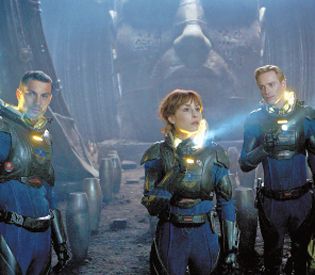In space, no one can hear you scream. But in 1979, audiences at Ridley Scott’s groundbreaking, science-fiction-horror-hybrid “Alien” there were shrieks aplenty. While Scott’s hotly anticipated “Alien” follow-up “Prometheus” has been described as everything from an “Alien” prequel to a companion piece, it in-arguably shares DNA with its landmark predecessor.
The “Prometheus” premise: Archaeologists discover ancient cave paintings of, you guessed it, aliens, and a team of intrepid explorers (Noomi Rapace, Charlize Theron, Idris Elba and Michael Fassbender as a robot) blast off to discover the origins of life on Earth.
Bad move.
Before heading off to catch a screening, it wouldn’t hurt to bone up on the acid-dripping, egg-laying, bloodthirsty forebears Scott first introduced to the big screen so many years ago.
The consensus about the first “Alien” was that no one had ever seen anything like it, except those of us who had. With its more lived-in, “2001: A Space Odyssey”-like attention to futuristic detail and S&M and bondage–inspired alien design by Swiss surrealist H.R. Giger, “Alien” was unique and an instant classic, adding the words “facehugger” and “chestburster” to the horror-movie lexicon.
Scripted by Dan O’Bannon (“Dark Star”) and Ronald Shusett (“Aliens”), “Alien” tells the simple tale of a terrifying and deadly alien creature (played by slender, 7-foot-2-inch London design student Bolaji Badejo in an elaborate, tight-fitting suit) on the loose inside the outer-space “commercial towing vehicle” Nostromo. “Alien” was, like “Jaws” (1975) and “Star Wars” (1977), another case of a B-movie concept getting the A-list treatment from a visionary young director. Indeed, the “Alien” screenplay was pitched to studios as “‘Jaws’ in space.”
The film’s ensemble cast was superb, including English actor John Hurt, whose big scene has become a cinematic touchstone, and Sigourney Weaver in her signature role as Lt. Ellen Ripley.
Fans of horror and sci-fi recognized that “Alien” owed a conspicuous debt to the 1958 B-movie “It! The Terror From Beyond Space,” which features veteran stuntman and Western actor Ray “Crash” Corrigan in a less impressive, but sufficiently frightening, rubber monster costume.
But nothing compared to Giger’s creature. With its death’s head “face,” phallus–shaped skull and snapping, slavering jaws-within-jaws, the Giger-designed Alien was unlike anything the movie-going public had ever seen. Like the mummy, Frankenstein monster, King Kong and Godzilla, the “Alien” creature has long since been admitted into the pantheon of greatest movie monsters of all time.
“Aliens,” the 1986 follow-up to Scott’s landmark, turned out to be one of those rare sequels that, if not better than the original, was great in its own way, thanks largely to a young director from the Roger Corman School of B-Movies named James Cameron (you remember him). Weaver returned as Ripley as she would twice more. 20th Century Fox and the “Alien” producers deserve credit for maintaining high standards for the “Alien” franchise, especially in regard to choosing directors.
“Alien 3” (1992) may have been a misfire, but it was a fascinating misfire, dir-ected by a young up-and-comer named David Fincher- (“The Social Network,” “The Girl with the Dragon Tattoo”).
The same is true of Jean-Pierre Jeunet’s “Alien Resurrection” (1997), which in spite of its flaws, features one of the most unforgettably nightmarish horror-movie chase sequences ever filmed.
Scott (“Blade Runner,” “Kingdom of Heaven,” “Gladiator,” “Black Hawk Down”), now revisiting one of his early triumphs, has made many films that have withstood and rewarded repeated viewings, a sure sign of his greatness as an artist (of course, he’s never won an Academy Award for directing).
Numerous “Alien”–inspired books, video games, comic books and “Alien vs. Predator” films later, we anticipate Scott’s “Prometheus” and its origin story and hope Scott makes us scream all over again.

